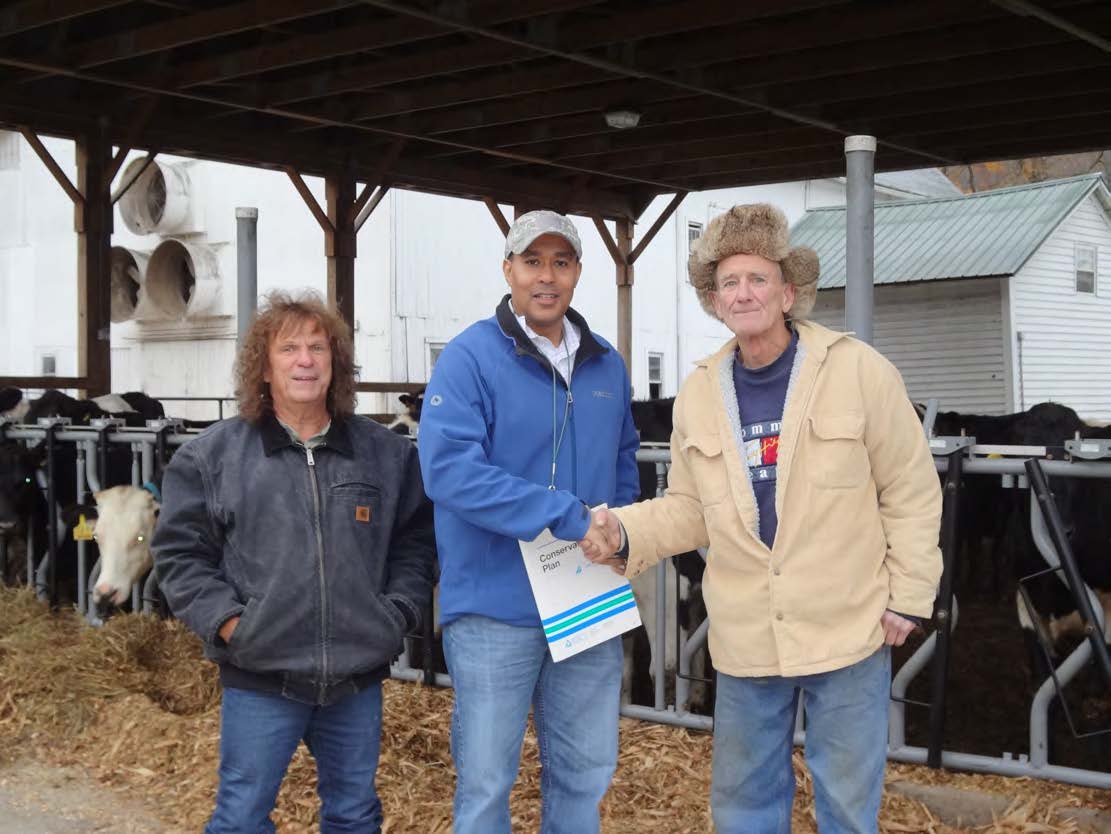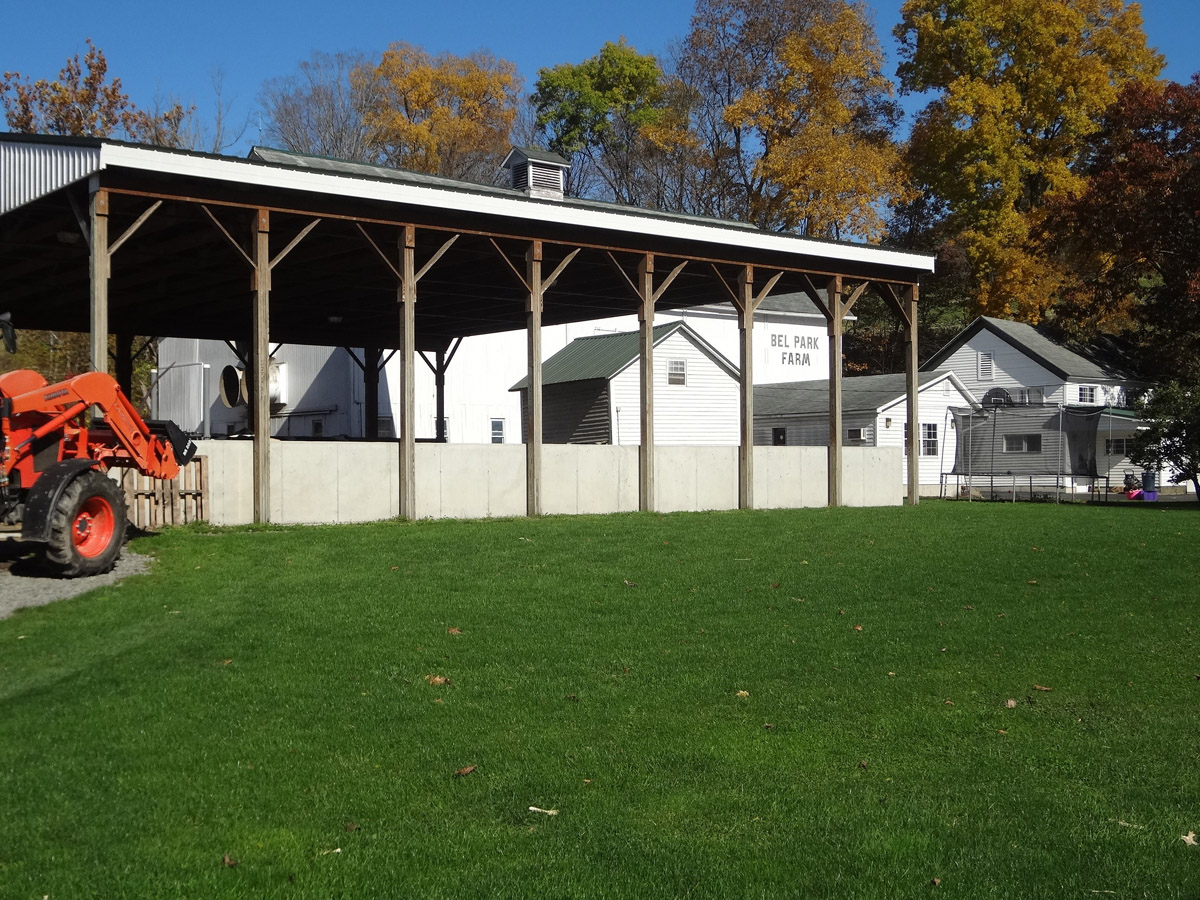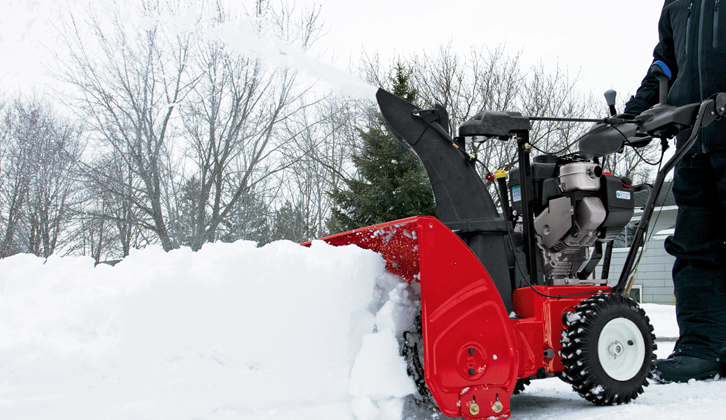|
A Long Term Success Story
Submitted By Ain Welmon and Bob Wagner
John W. Parks, of Hickory Grove in Susquehanna County Pennsylvania, currently operates a 75-head Holstein dairy operation on 230 + acres of owned and 150 acres of rented ground. He grows silage corn, alfalfa, mixed grass hay and sweet corn. The dairy herd seasonally grazes 50 acres of pasture. There are 40 acres of flat, well drained crop producing soils along the Susquehanna River where the sweet corn, silage corn and alfalfa grow.
The farm has a custom firewood cutting business run by his son, Wes who does the milking and haying in addition to being a full time school teacher. Mr. Parks noted, “I grew up on this family farm milking cows. Since 1867 there have been six generations on this farm; I’m the fifth and my son, Wes is the sixth.” Mr. Parks, now 71, worked off of the farm as a civil engineer for International Paper Corporation (IPC). In his spare time when he was not engineering for the IPC or dairy farming at home he was a dirt track race car driver at several local race tracks in Northern Pa. and Southern NY.
The Parks farm, “Bel Park Farm”, has been working with the US Department of Agriculture (USDA) since 1948 when the Soil Conservation Service first came to Susquehanna County. The first farm conservation plan was written, (Plan #36 according to Susquehanna Conservation District records) for J. L. Parks (John’s father). Updates to the original farm plan were completed in 1991 and 2001.
In 2010 Mr. Parks started a new round of soil and water conservation efforts by working with USDA Natural Resources Conservation Service (NRCS) District Conservationist (DC) Ain Welmon. Mr. Parks and DC Welmon worked together to identify the resource concerns on the land, and the needs of the landowner in the development of a new farm conservation plan.

Pictured left to right are: Natural Resources Conservation Service (NRCS) Project Inspector John Benscoter, USDA NRCS District Conservationist Ain Welmon and Land owner John Parks standing in front of the concreted heavy use area, feeding area and manure storage facility.
Mr. Parks applied to the USDA NRCS for an Environmental Quality Incentive Program (EQIP) Livestock contract, in 2012. The new farm conservation plan, the timely EQIP application, and site consultations (engineering inventory and evaluations) with Mr. Parks by NRCS Engineers and Technicians put the operation on the right road to getting a livestock contract. The Engineering Inventory and Evaluation (I & E) provided technical (engineering) assistance that was needed to identify specific conservation practices that would help the operation better manage its cows and manure, combat erosion, improve water quality, and air quality.
In 2013 Mr. Parks was notified that he would receive financial assistance from the Susquehanna Conservation District via a Growing Greener Grant and from the USDA NRCS for an EQIP Livestock contract. The new contracts would provide financial and technical assistance to build the roofed concrete floored hua and manure storage facility, improved access to road, animal trail and walkways, structures for water control, underground outlets, subsurface drainage, rain gutters and downspouts, fencing and 2 acres of pollinator habitat. NRCS supplied technical assistance (onsite inspection) and follow-up during the construction of the various conservation projects over the next three years.

In 2017 John continued to improve his operation by installing 6000+ feet of 4 strand hi-tensile fencing around a 20 acre pasture field. The Parks family continues to actively manage their 90 acres of woodland, as they have since the first conservation plan (1948) identified woodland management as a priority.

Plans for 2018 include working with both the Susquehanna Conservation District (financial) and the NRCS (technical assistance) on plans to complete a new watering system that will supply water (improved water quality) for the 35+ acres of pasture. The watering system conservation practices include: new round concrete water troughs, reinforced gravel pad around the water trough area to prevent erosion (mud), underground outlets, water collection lines and livestock pipeline.
John reflected for a few seconds when asked what he thinks of his heavy use area concrete floor and roofed areas (barnyard and manure storage) before he strongly stated, “I LOVE IT! It has worked out great. There is nothing I want to change on it, nothing at all. I would definitely recommend NRCS to other farmers. They do great work”.
Back to Top
Feeling Thankful For Local Dairy
Submitted By Susquehanna County Dairy Ambassador, Mary Catherine Chidester
With Thanksgiving right around the corner, many people may be thinking about what they are thankful for; their family, food, warm clothing, school, the list can go on forever. If you ask me, I would say that I am thankful for dairy. We should be thankful for the dairy industry, because it provides healthy milk and helps maintain a strong local economy.

Mary Catherine Chidester
Healthy milk is one aspect of the dairy industry we should be thankful for. Milk has nine essential nutrients necessary for a balanced diet and healthy lifestyle. Milk contains these nutrients: calcium, potassium, phosphorus, protein, Vitamin A, vitamin B12, vitamin D, riboflavin, and niacin. In fact, milk is very good for you. It is recommended that you eat “three every day” of milk, cheese, and/or yogurt. The dairy industry provides this milk for us, and for that, we should be thankful.
We should also be thankful for the dairy industry because it helps preserve a strong, local economy. The dairy industry positively impacts many local businesses. Dairy farms spend 85 percent of their income to support local businesses and the community tax base, according to the Center for Dairy Excellence. The dairy industry also provides about 60,000 jobs throughout Pennsylvania. We should be thankful for the dairy industry because without it, local economies would not be generating as much revenue.
This Thanksgiving, I hope you keep the hard-working men and women of the dairy industry in your thoughts. We should all be thankful for the dairy industry because it provides healthful milk and helps keep a thriving local economy.
Happy Thanksgiving from the Susquehanna County Dairy Promotion Team.
Back to Top
Rick Soden Joins Honesdale Bank
David E. Raven, President and CEO of The Honesdale National Bank, announced that Richard Soden has joined the bank as a Vice President and Commercial Loan Officer.

Rick Soden
In making the announcement, Mr. Raven stated, “We are extremely pleased to add Rick as an integral part of our HNB family. His experience, dedication, and personality are ideally suited for delivering the personal attention and hometown service our bank is noted for. He recognizes the important role our bank plays in the communities we serve and is committed to building and enhancing those relationships.”
Soden brings 35 years of banking experience with him to HNB, the most recent 25 years as a Commercial Lender/Relationship Manager in Susquehanna and Wayne Counties. Initially, he will work out of Honesdale National’s Lakewood and Forest City Offices and will primarily service commercial clients in Susquehanna and Northern Wayne and Lackawanna Counties. Mr. Soden can be reached by calling 800-HNB-9515 or by sending an email to rsoden@hnbbank.com.
Rick is a veteran of the United States Air Force and holds an Associate in Science Degree from Penn State University in Business Administration. He is a graduate of the Pennsylvania Bankers Association’s Central Atlantic Schools of Trust and Commercial Lending, both held at Bucknell University in Lewisburg, PA.
Active within the community, Mr. Soden is an Executive Committee Member of the Northern Tier Regional Planning Development Commission and Chairman of their Local Loan Committee. He serves as a member of the Susquehanna County Industrial Development Authority and is a lifetime member of the Thompson Hose Company. Having been raised on the family farm in Starrucca, he is an avid outdoorsman.
Rick and his wife, Sharon, reside in Thompson Township, Susquehanna County and are the proud parents of four sons, Adam, Brent, Craig, and Aaron, all Penn State University graduates.
The Honesdale National Bank, established in 1836, is the area’s oldest independent community bank headquartered in Northeastern PA, with offices in Wayne, Pike, Susquehanna, Lackawanna, and Luzerne Counties.
Back to Top
Brighten Indoors with Amaryllis
Submitted by Melinda Myers
Brighten those gray winter days with a few colorful, easy-care amaryllis. The 6- to 10-inch trumpet shaped blossoms are sure to generate a smile and brighten your mood. And consider sharing the fun of growing these beauties with friends and families. Watching the bulbs transform into beautiful blossoms is an experience everyone will enjoy – and it’s a gift that requires no dusting.
When buying amaryllis, purchase large bulbs for the biggest and longest lasting floral display. One jumbo bulb will send up multiple flower stems over several weeks. Smaller bulbs can be planted two or three to a pot to create a living bouquet.

Photo by Longfield-Gardens.com
Try some of the newer varieties like ‘Lagoon’ and ‘Red Pearl’. Their ten-inch blossoms are sure to enliven any indoor decor. Grow the ‘Nymph’ series of double amaryllis if you prefer large flowers on shorter stems. ‘Cherry Nymph’ has a rose-like beauty with layers of fire engine red petals.
And for something different, grow amaryllis ‘Evergreen’ with long and narrow, pale chartreuse petals. Large bulbs will have two or more stems, each with four or more flowers. Or plant the uniquely shaped ‘Exotic Star’ with garnet red stripes and apple green highlights on ivory petals.
Grow your amaryllis in a pot with drainage holes and use a quality potting mix. Plant large bulbs in individual pots that are seven to eight inches deep and five to six inches across. Or group several bulbs together in a larger container.
Look for unique containers or decorative baskets to showcase these beauties. To see some creative ways to display and decorate your home with amaryllis, download a free Winter-Blooming Bulbs Inspiration Book (longfield-gardens.com).
When planting amaryllis bulbs, the top half of the bulb should stay above the soil surface. You can dress up the container by covering the soil surface with moss or decorative stones. Water the potting mix thoroughly after planting, and place the container in a cool (60-65°F), bright location. Water sparingly until the sprouts appear, and then start watering weekly, allowing the soil to dry out in between.
Or go soilless. Place several inches of pebbles in the bottom of a glass vase or watertight container. Cover the pebbles with water. Set the bulb on top of the pebbles and add more stones around the bulb to hold it in place. Add water as needed, keeping the water level just below (almost touching) the bulb.
Now relax and wait the month or more needed for your amaryllis bulb to wake up and start growing. Flower buds usually emerge before the leaves, but sometimes the leaves come first. When the buds begin to open, move your amaryllis away from direct sunlight to extend the flower display.
You can also display these magnificent blooms in a vase. Wait until the buds are soft and showing a little color, then cut the stems to the desired length and place them in a clean vase with fresh water.
To keep your blooming plant looking its best, use scissors to remove individual flowers as they fade. Cut the entire stem back to the bulb once it has finished blooming. And watch for a second or third flower stem to appear. Some bulbs produce multiple stems at one time while others rest a week or two before sending up another flower stem.
That’s all there is to it. Just plant, water and place in a brightly lit location for weeks of fresh, colorful flowers this winter.
Editors Note: Melinda Myers has written numerous books, including Small Space Gardening She hosts The Great Courses “How to Grow Anything” DVD series and is a columnist and contributing editor for Birds & Blooms magazine. Myers was commissioned by Longfield Gardens for her expertise to write this article. Myers’ website is www.melindamyers.com.
Back to Top
Become A Foster Grandparent Now
The Foster Grandparent Program is sponsored by the B/SS/T Area Agency on Aging, Inc. and is funded in part by the Corporation for National and Community Service. The Foster Grandparent Program places income eligible seniors, 55 and older, in school classrooms, Head Start centers, and day care centers to provide extra support for students who have special or exceptional needs or who are low-income.
Foster Grandparents volunteer in exchange for a small stipend and are reimbursed for their travel. Volunteer’s schedules vary depending on the needs of the volunteer and school. Foster Grandparents can volunteer as little as 15 hours a week up to 40 hours per week.
Teachers find Foster Grandparents very helpful, particularly with those students who are struggling. Teachers assign Foster Grandparent to help children in the classroom that need extra assistance. The one-on-one time the spent with the assigned children can help to increase the child’s confidence, social skills, and academics.
Last school year, 67 Foster Grandparents served over 300 students throughout Bradford, Sullivan, Susquehanna, and Tioga counties. Over 48,000 hours of extra help was given by Forster Grandparents to students.
To learn more about the Foster Grandparent Program call 1-800-982-4346.
Back to Top
Virtual Farm Is Now Accessible
Submitted by Amy Duke, Penn State Ag Sciences
Changing weather patterns pose significant challenges for modern dairy farmers -- excessive hot or cold temperatures, drought and humidity can have a detrimental effect on cows' health, which ultimately can lead to decreased milk production.
Deciding how best to react to those changes to ensure the vitality of dairy farms -- while being good stewards of the environment -- can present a bit of a conundrum for some farmers, especially if they are pressed for time and resources. What are the best management practices? Are there technologies that can help? Is there current research on the subject?
Now, those farmers can see sustainability principles in action with just a few clicks of mouse, thanks to an interactive "virtual farm" website developed by researchers in Penn State's College of Agricultural Sciences and Penn State Extension, in partnership with the project's lead, the University of Wisconsin-Madison, Cornell University and the Dairy Innovation Center.
"The objective of this project is to provide a 'one-stop shop' for all dairy sustainability information," said Eileen Fabian, professor of agricultural engineering and environmental biophysics in Penn State's Department of Agricultural and Biological Engineering. "The beauty of it is that one can take a tour of a sustainable dairy farm without stepping foot on an actual farm. The resources are accessible, free and can be viewed at anytime from anywhere."
Fabian explained that the catalyst for this major undertaking was a growing movement in the dairy industry to adopt practices that mitigate the negative effects of agricultural operations on the environment, while securing the future sustainability of farms.
In Pennsylvania alone, there are 6,650 dairy farms -- the second largest number of dairy farms nationally -- according to the Center for Dairy Excellence. In addition to producing 10.7 billion pounds of milk annually, the state's dairy industry provides 60,000 jobs and has an estimated annual economic impact of $7 billion.
"It's a tremendous industry, and its people really care about the environment and their farms," Fabian said. "Those farmers want to do their part to protect the integrity of soil, water, air and animal habitats and to keep agriculture a strong industry. And it's our mission at Penn State to help them do just that -- we believe this website will really help to move the needle."
The website, designed and developed by the creative services team at Penn State's WPSU, has two virtual farms: one is a model of a 1,500-cow facility, while the other is a smaller-scale operation of 150 animals. Users can click on the various aspects of the farm, such as pastures, housing, manure storage facilities, feed silos, milking facilities and more, and information related to that specific area will pop up, allowing for further exploration.
Topics include herd management, feed management, milk production, crops and soils, manure management and greenhouse gases. The site's database includes a broad range of articles, extension fact sheets, models, images and graphics. The layers of information range from exploration of the farm site with basic information to higher levels of technical and research information, data, and models.
For example, if one clicks on the manure storage facility, several links will appear, enabling viewers to scan information on manure management plans, potential hazards caused by improper treatment, preventing infiltration into surrounding water sources, and other subjects.
"The site is user-friendly, meaning it's fairly easy for users to interact at a level they feel comfortable with," Fabian said. "They can keep it simple or dig down deep and find peer-reviewed research papers."
Fabian said a project of this magnitude requires interdisciplinary collaboration, and she acknowledged the support of Penn State researchers Daniel Hofstetter, extension and research assistant in agricultural and biological engineering; Tom Richards, professor of agricultural and biological engineering; Heather Karsten, associate professor of crop production/ecology; Douglas Beegle, distinguished professor emeritus of agronomy; and Robert Nicholas, research associate, and Chris Forest, associate professor of climate dynamics, College of Earth and Mineral Sciences.
Now that the team successfully has launched its website, Fabian sees great potential in creating additional virtual farms, perhaps focusing on poultry production and animal welfare issues.
The five-year project received a $10 million grant from the Coordinated Ag Project Program of the U.S. Department of Agriculture's National Institute of Food and Agriculture.
To tour the farm, visit http://virtualfarm.psu.edu. Additional information about best practices and sustainability information can be found by visiting the Penn State Extension website at https://extension.psu.edu.
Back to Top
Courthouse Closed
The Susquehanna County Commissioners wish to announce the Courthouse will be closed on Thursday and Friday, November 23 and 24 in observance of Thanksgiving. All court related offices will be available.
Back to Top
Farmers To Benefit From Congress Act
The Beginning Farmer and Rancher Opportunity Act was recently introduced in Congress by Reps. Tim Walz (D-MN) and Jeff Fortenberry (R-NE).
The bill is to ensure the 2018 farm bill focuses on the future of American agriculture by driving investment toward programs and policies that create opportunities for the next generation of farmers and ranchers.
The Center for Rural Affairs understands the challenges beginning farmers and ranchers face, and has endorsed the Beginning Farmer and Rancher Opportunity Act.
According to Anna Johnson, Center policy program associate, the average age of today’s farmer is 58 years old. Over the course of the next five years (the duration of the next farm bill), nearly 100 million acres of farmland are predicted to change hands.
“While some retiring farmers and ranchers will pass their land and operations to their children or other relatives, many are heading toward retirement without a succession plan in place,” Johnson said. “And, beginning farmers taking over lack guidance. We need to support policies that ensure they have the necessary tools and resources to be successful.”
The bill expands beginning farmer and rancher access to affordable land; empowers producers with the skills needed to succeed in today's agricultural economy; ensures equitable access to financial capital and federal crop insurance; and encourages commitment to conservation and land stewardship.
“We stand with the congressional sponsors of this legislation in supporting beginning farmers and ranchers,” said Johnson. “The Beginning Farmer and Rancher Opportunity Act should be included in the 2018 farm bill.”
Back to Top
Snow Blower Safety Tips
Submitted By Debbi Mayster on behalf of OPEI

Winter is on its way – and clearing driveways, sidewalks and parking lots is no small job. It’s important to get ready before flurries and heavier snows arrive. The Outdoor Power Equipment Institute (OPEI) is offering tips for safe and correct use of snow throwers, often referred to as snow blowers.
“Weather today is more unpredictable than ever, and you need to have your snow thrower serviced and ready to power up,” says OPEI President and CEO Kris Kiser. “You want to have the right fuel on hand and review your owner’s manual now so you can use your equipment safely.”
Kiser says preparation is key and that home and business owners should consider the following tips:
PREPARE BEFORE IT SNOWS
Review your owner’s manual. Check your owner’s manual for safe handling procedures. If you lost your manual, you can look it up online (and store a copy on your computer so you have the manual available to reference in the future). Review how to operate the controls. You should be able to shut off your equipment quickly.
Check your equipment. The snow thrower should be completely powered off when you are checking it over. If you forgot to drain the fuel last winter before storing your snow thrower, drain the gas tank now. Adjust any cables. Check the auger.
Put your equipment where you can get to it easily. Move your equipment to a convenient and accessible location, so you can get to it easily when you need it.
Purchase your fuel. Often gas stations are closed after a storm. Be sure to use the correct fuel, as recommended by your equipment's manufacturer (for more information on fueling properly see www.LookBeforeYouPump.com). Fill up the fuel tank outside before you start the engine and while the engine is cold. Never add fuel to a running or hot engine.
Store your fuel properly. Place fuel in a fuel container and label it with the date purchased and the ethanol content of the fuel. Fuel that is more than 30 days old can phase separate and cause operating problems. It’s important to use fresh fuel in your snow thrower. Make sure fuel is stored safely and out of the reach of children.
Tidy the area you intend to clear with your equipment. Snow can sometimes hide objects. Doormats, hoses, balls, toys, boards, wires, and other debris should be removed from the areas you intend to clear. When run over by a snow thrower, these objects may harm the machine or people.
Plan to dress for winter weather. Locate your safety gear now, and place it in an accessible closet or location in your home. Plan to wear safety glasses, gloves and footwear that can handle cold and slippery surfaces.
OPERATE YOUR EQUIPMENT SAFELY
KEY SAFETY TIP: Never put your hands inside the auger or chute. Use a clean out tool (or stick) to unclog snow or debris from your snow thrower. Your hands should never go inside the auger or chute.
Turn OFF your snow thrower if you need to clear a clog. If you need to remove debris or unclog snow, always turn off your snow thrower. Wait for all moving parts to come to a complete stop before clearing any clogs or debris.
Only use your snow thrower in visible conditions. Never operate the snow thrower without good visibility or light.
Aim your snow thrower with care. Never throw snow toward people or cars. Do not allow anyone to stand in front of your snow thrower. Keep children or pets away from your snow thrower when it is operating.
Use extreme caution on slopes and hills. Use caution when changing directions on slopes. Do not attempt to clear steep slopes.
Know where your cord is. If you have an electric powered snow thrower, be aware of where the power cord is at all times. Avoid tripping. Do not run over the power cord.
Keep pets and children inside. Kids and pets may love to play in the white stuff, but it’s best to keep them inside your home and under supervision while you are using your snow thrower to clear a path or drive. Do not allow them to play in the snow as it is tossed out of the snow thrower’s chute.
More safety tips and information are available at www.opei.org.
Back to Top
Warmer Home this Winter
Dreading the cold drafts and rising heating bills that come with winter? You’re not alone. Nearly two-thirds of Americans live in homes that need to be weatherized to improve heating efficiency and maximize comfort, but many still don’t take the time to do so, according to a survey conducted by OnePoll for Duck brand.
Why? The cold reality is that most people simply don’t know what to buy or where to start when it comes to weatherizing their homes. But, preparing your house for chillier weather can be as easy as following some step-by-step instructions or consulting a brief how-to video. Here are a few tips to get started.
1. Secure Seals by Weatherstripping. Windows and doors are the two largest draft sources in any home, leading to high heating costs and an uncomfortable living environment. For these reasons, they should be top priorities.
To combat these sneaky air leak spots, use high-strength weatherstripping, such as Duck brand MAX Strength Silicone Weatherstrip Seal. This strong, flexible material makes it easy to seal gaps of different sizes around windows and doors.
2. Dodge Door Drafts. Assess your doors for potential drafts and energy loss, as everyday wear and tear can wreak havoc on thresholds and door seals. Depending on the door style, there are several solutions that provide multiple layers of protection, such as door shoes, draft seals and door sweeps. Most are easily customizable to meet your door width simply by cutting the product down to size. Online videos can provide step-by-step instructions that show you exactly how to install a variety of different door weatherization solutions.
3. Winterize Windows. There are additional defenses for your windows, such as Duck brand Roll-On Window Insulation Kits. With a few simple steps, you can insulate windows while maintaining a crystal-clear view. These kits offer a pre-taped top for quick and easy roll-on film installation. Plus, there’s no measuring required and they fit snugly to window frames for the duration of the winter season. To learn how, watch this how-to video: youtube.com/watch?v=ZY8qialgEW0.
4. Cover Sneaky Attic Entranceways. Finally, don’t forget about attic access openings or pull-down stairs as a source of air leaks. Since they’re usually not insulated, they can be a considerable culprit of energy loss in your house. How do you prevent this? An attic stairway cover is a simple solution to combat heat loss. Plus, they’re flexible, lightweight and easily repositioned to maintain direct access to the attic.
For more project ideas and product information, visit DuckBrand.com.
Don’t be left in the cold this winter. By taking a few measures, you can prepare your home against drafts and air leaks during the wintry months. (StatePoint)
Back to Top
Courthouse Report
Bench Warrants
The Susquehanna County DOMESTIC RELATIONS Section has outstanding BENCH WARRANT'S for the following individuals as of 9:30 a.m. on November 9, 2017: Brian M. Anderson, Ryan A. Aukema, Amanda C. Bedell, Christina L. Birchard, Tonya S. Birchard, Allen S. Bowman, James L. Bradley, Brandon J. Cicon, Jeremy T. DeGraw, Tina Dolan, Nathasha Everett, Morgan A. Garcia, Vincent Gordon, John J. Haney, Timothy M. Holmes, Bryan Homsher, Tara M. Humphry, John J. Jenisky, Jr., Jean M. Larson, Todd J. Layton, Charlie J. Legere, Shawn N. Marcho, Bradley W. Megivern, Peggy J. Mills, Ralph J. Minnick, Paul Newhart, III, Zachary A. Nybeck, Carol Parker, Charles Perry, Vincent J. Petriello, Matthew J. Setzer, Richard D. Shoemaker, Robert Staff, Tyrone M. Taylor, Justin S. Thompson, Renee A. Valentine, Charles Vanwinkle, Jr., Robert C. Walter, II, Jeffrey Warner, William R. Wayman, Jr., Brandi R. Wayman, Jr., Roderick R. Williams, Eric W. Zick. Please contact the Domestic Relations Section at 570-278-4600 ext. 4050 with any information on the location of these individuals.
Deeds
Mark A. Carlton and Mary Jo Carlton to Eric Jerauld and Michele Jerauld for $400,000.00 in Bridgewater Township.
Kenneth G. Miller to Mark Troccia for $135,000.00 in Silver Lake Township.
John Mcallister to Richard V. Weida and Jill A. Weida for $14,400.00 in Lenox Township.
Martin E. Price and Florence D. Price to Rebecca White for $45,000.00 in Liberty Township.
Engelina Raun (ESTATE) to Michael D. Pipitone and Alexandria M. Pipitone for $157,000.00 in Bridgewater Township.
Robert J. Hunter to Robert J. Hunter (TRUST) in Herrick Township.
Corrective: Marsha L. Pratt (BY SHERIFF AKA) Marsha Pratt (BY SHERIFF), Walter E. Pratt (BY SHERIFF AKA) Walter Pratt (BY SHERIFF), Appalachian Basin Minerals LP (BY SHERIFF), Pennmarc Resources II LP (BY SHERIFF), Wildes Mineral Interests LLC (BY SHERIFF) McCrow Energy Partners II LLC (BY SHERIFF) to Williams Field Serivces Company LLC for $110,201.00 in Bridgewater Township.
Alexander Curtis to Mark Stark for $65,000.00 in Thompson Borough.
Robert L. Snyder III and Joylyn G. Snyder to Charles Alton Allen for $230,000.00 in Silver Lake Township.
Frank Valentine to Angelina Gathering Co. LLC for $10.00 in Lenox Township.
Randi Morcom and Carla Morcom to Jeffery Mikloiche and Joan Mikloiche for $156,000.00 in Clifford Township.
Patricia Odell and William Odell to Nicholas Vales for $118,500.00 in Thompson Borough.
Colleen A. Millard, Dale R. Foster, Robin J. Foster, Kenneth M. Foster, Amy J. Foster and Donna L. Foster to Kim M. Thompson for $165,000.00 in Silver Lake Township.
Edmund W. Burdick (AKA) Edmund W. Burdick JR and Judith A. Burdick to Michael Silvia and Paula Silvia for $196,000.00 in Gibson Township.
Watson J. Dayton and Lee Anne Dayton to Urania Tennant, Terry Larue, Jared Tennant and Sarah Smith for $1.00 in Rush Township/Jessup Township.
Elsie Groiss (ESTATE) to Gregory M. Groiss and Denise A. Groiss for $112,200.00 in Dimock Township.
Fred J. Carden and Karen E. Carden to John V. Oliver and Tonia L. Oliver for $420,000.00 in Forest Lake Township.
Grace D. Bailey (ESTATE) to Elizabeth Engle for $1.00 in Liberty Township.
Corwin Living Trust (BY TRUSTEE) to Kevin L. Corwin, Linda M. Tighe and Nancy L. Vaccaro for $1.00 in Montrose 2W.
Philip J. Michaels and Lori A. Michaels to Mark Michaels and Andrea Michaels for $83,750.00 in Jessup Township.
Frederick W. Knowlton, Cody J. Knowlton and Brianna Knowlton to Frederick W. Knowlton for $1.00 in Lenox Township.
DTH REO INC to Jessica Manning for $28,500.00 in Brooklyn Township.
Cartus Financial Corporation to Nicole Lynn Trieste for $175,000.00 in Auburn Township.
Appalachian Basin Minerals LP, Pennmarc Resources II LP, Wildes Mineral Interests LLC and McCrow Energy Partners II LLC to Neal C. Chidester, Sonya Chidester and Ryan Chidester for $190,000.00 in Brooklyn Township.
Lee S. Gunn and Nova S. Gunn to Michael Girjakowicz and Sandra Anderson for $70,000.00 in Franklin Township.
Virginia Betley (NBM), Virginia Yost and Craig Yost to Donald Hackett for $165,000.00 in Bridgewater Township.
Helen M. Pretko (AKA) Helen Marie Pretko and John Onysko to Todd W. Smith and Deborah Loomis Smith for $20,000.00 in Bridgewater Township.
Francis R. Mckeon SR (AKA ESTATE) Francis R. Mckeon (AKA) Francis R. Francis JR, Francis R. Mckeon JR< Sharon A. Fallon, Edward Mckeon JR, David Mckeon, Georgeann Mckeon, Mary Ann Jennings, David Jennings, Amy C. Mckeon and Jeffrey Mckeon to Fred Sherman and Susan Sherman for $239,000.00 in Springville Township.
Kenneth E. Singer and Kay M. Singer to Holly M. Singer for $1.00 in Bridgewater Township.
Lawrence C. Bogdan and Judith Ann Bogdan to Bremer Hof Owners Inc for $100.00 in Herrick Township.
Arnold Bennett and Dawn Marie Bennett to Bennetts Auto Repair LLC for $165,000.00 in Silver Lake Township.
Dakota Berg, Elizabeth Berg (AKA) Elizabeth M. Berg to Gregory C. Nixon for $159,500.00 in Montrose 2W.
Jerry Knight, Bobby Jo Johnson (AKA) Bobby Jo Knight (AKA) Bobbi Jo Knightt to Jerry Knight for $1.00 in Franklin Township.
Martha Chamberlain ( BY ATTN'Y IN FACT) to Alice M. Days for $80,000.00 in Dimock Township.
Wilmington Trust to Maria Colangelo and Mary Taylor for $20,000.00 in Herrick Township.
Neil A. Richards and Lucille C. Richards to Crystal MacNeil for $79,000.00 in Herrick Township.
Michael Ryder and Mary Jane Ryder to Michael P. Hurlburt for $62,765.00 in Oakland Borough.
Garth V. Goodman ( BY ATTY) and Erica L. Goodman (BY ATTY) to Lauren M. Reddon for $83,500.00 in Oakland Borough.
Edmund M. Zack, Kathleen Zack, Steven H. Coakley, Patricia A. Baker and Robert McGonagle (ESTATE) to Stephen Duick for $309,000.00 in Herrick Township.
CitiFinancial Serving LLC (BY ATTY) to James Vanloon, Mindi Valoon and Michael Welsch for $30,000.00 in Herrick Township.
Ulyssess S. Arnold II and Jennifer M. Arnold to Nadine Lucas for $50,000.00 in Choconut Township.
Mary Irene Caffrey (ESTATE) to Nadine A. Chapman for $1.00 in Lanesboro Borough.
Thomas W. Davis (ESTATE AKA) and Thomas Willard Davis (ESTATE) to Charlotte M. Davis for $1.00 in Brooklyn Township.
Thomas W. Davis (ESTATE AKA) and Thomas Willard Davis (ESTATE) to Charlotte M. Davis for $1.00 in Brooklyn Township.
Back to Top
Pet of the Week
Submitted by True Friends Animal Welfare Center, 16332 SR 706, Montrose, PA 18801. Phone 570-278-1228 Website: truefriendsawc.com

Ellie
This sweet girl was found in a ditch and brought to our shelter several weeks ago emaciated,dehydrated, and covered in infected skin sores. This little angel was in desperate need of help, but thanks to our dedicated supporters she was able to receive urgent medical care. Lovingly named Ellie, she is rapidly recovering in our quiet room at True Friends and seems to really love the soft blanket and bed our team has given her. It’s really difficult to imagine what this innocent, adorable dog has been through before coming to our shelter, but she is now a happy, affectionate, sweetheart ready to start her new beginning. Ellie would make a great addition to any family willing to make up for what she has been through by pampering and spoiling her for the rest of her life. If that may be you, please stop by and meet Ellie. You will surely fall in love!!!
This precious dog and her very sad story has inspired one of our supporters to match every dollar donated up to $1500 to our medical fund. This will allow us at True Friends to continue our life saving work and being able to help every animal brought to our door step. Please look into your heart and into Ellie's grateful eyes, and you will understand why we cannot give up on our mission of hope and healing. Your donation will be matched and can be made on our site: truefriendsawc.com
Back to Top
| Last modified: 11/14/2017 |
© |
|





















